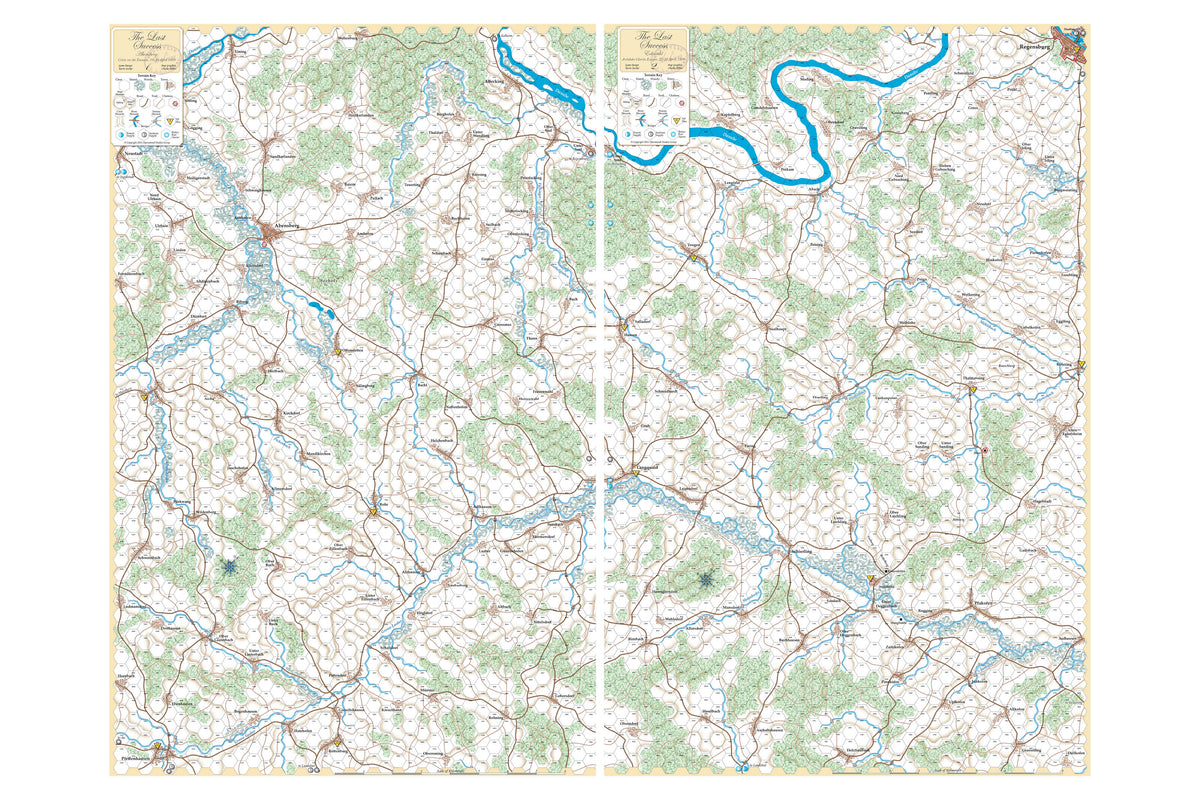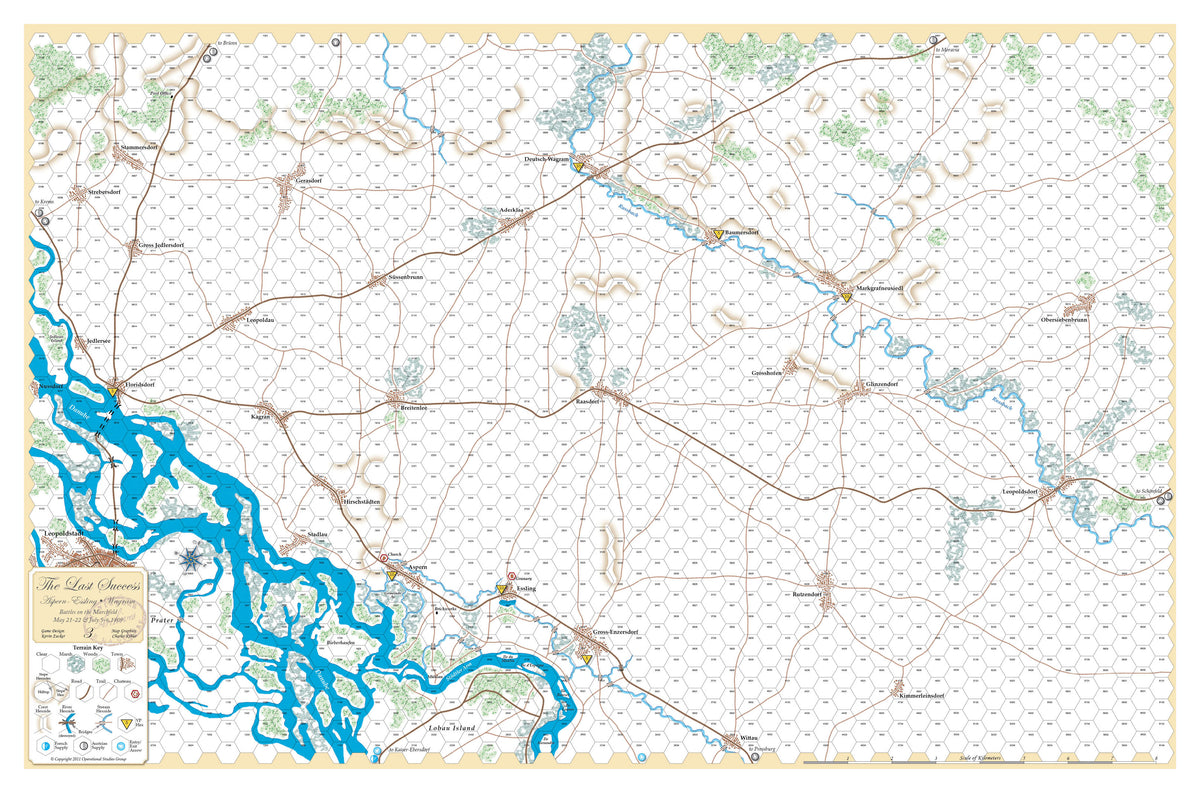
The Last Success
These four games explore the major battles of 1809, where Napoleon and his Army of Germany met their first setback in the shadow of Vienna, against a modernized Austrian Army under Archduke Charles . Each game shows the approach to the battlefield on the day before battle. The Wagram and Aspern-Essling games share one and the same battlefield on one map. Set at the scale of Napoleon's Last Battles-525 yards per hex and one hour turns-the game retains the Command System of Commanders and Corps Officers. This title is expected to go out of print within 90 days.
battles simulated
Abensberg Crisis on the Danube, 19-20 April
Reaching Bavaria one week after the Austrian invasion, Napoleon had to make up for lost time to regain the initiative. Archduke Ludwig’s V Corps and the small II Reserve stood scattered and isolated on the Austrian left wing. After uniting with Davout’s III Corps, Napoleon easily repulsed Ludwig in a series of rear-guard actions at Offenstetten, Biburg, Siegenburg, and Rohr, with the Bavarian and Württemberg troops under the Emperor’s immediate command. Marshal Hiller’s intervention with the Austrian VI Corps finally delayed the pursuers at Rottenberg. With the escape of the Austrian left at Landshut, Napoleon turned his attention toward Eckmühl.


Eckmuhl Archduke Charles Escapes, 21-22 April
At Eckmühl (Eggmühl), Napoleon encountered Charles’s rearguard on the road to Regensburg. Charles did not engage the bulk of his army, preparing instead for withdrawal off the map.
Aspern-Essling A Rebuff for Napoleon, 21-22 May
After the French capture of Vienna, the retreating Austrian garrison destroyed the great Tabor bridge. The Archduke’s army was approaching on the opposite bank of the Danube and the French needed to get across before Charles had a chance to defend the riverbanks. Lobau Island was selected as the point d’appui for a hurriedly-improvised pontoon bridge.
On the night of 19th-20th May, the first French division reached Lobau. By the following evening, 22,000 men had collected there and had bridged the Städtler Arm, crossing into the Muhlau salient. As warmer weather brought snow-melt from the mountains, the river began to rise. The desperate French engineers proved unable to keep extending the pontoon bridge. It broke free of its moorings, and Austrian fireships finished it off. Without reinforcements or supplies, the French defending Aspern and Essling were barely able to hang on. For the first time the Emperor himself had been personally defeated.


Wagram Battle on the Marchfeld, 5-6 July
After the battle of Aspern-Essling, Massena and the IV Corps remained on Lobau Island, while the other corps withdrew across the Danube. Napoleon planned a second crossing attempt, to be covered by a diversionary attack against the Muhlau. The real crossing, at the east side of the island, would prepare a French sweep around the open Austrian flank, where Nordmann’s weak Advance Guard stood unsupported. The crossing onto Lobau began at night on 4 July. By morning, the II, III and IV Corps were deploying on the Marchfeld. Charles, who had considered a forward defensive posture, at last decided to defend the Russbach Heights while advancing with his right along the Danube. The battle revolved around the villages of Markgrafneusiedl, Baumersdorf, Deutsch-Wagram and Aderklaa.
BONUS - The Battle of Teugen-Hausen, 20 April
Davout’s III Corps moved out from Isling toward Abensberg. The baggage train hugged the Danube, while the four divisions maneuvered to screen the trains.
The two III Corps Divisions of Friant and St. Hilaire found little difficulty in repulsing the ill-directed and lethargic Austrians with heavy loss, while their compatriots, Morand and Gudin, hurried their divisions westward through the dangerous Saal defile to join up with the Bavarians who were also engaged in the vicinity of Abensberg. The first two divisions were already past when vedettes from Hohenzollern’s Austrian III Corps appeared near Schneidhardt and Saalhaupt. From a hilltop overlooking Teugen, Kayser threatened the flank of St. Hilaire’s division column. After long fighting and a belated appearance by the Austrian Grenadiers, Hohenzollern was forced back from the ridgeline, allowing the French to exit.

GAME COMPONENTS
THE LAST SUCCESS
Each game includes:
Game Box
3 Maps 34"x22"
2 Counter Sheets (560 die-cut player pieces)
2 Booklets (System Rules and Study Folder)
20 Player Aid Cards (TRC x 4, Casualty x 2, Weather, Setup x 11, Reorganization, Combat)
5 Resource Cards (Booklet of Card Instructions, Combat Tables Folder, Sequence of Play, Victory Worksheet).
2 Card Decks (50 cards each)
Visit our Game Components section for details

Thursday Night Gamers
The Last Success
The Thursday Night Gamers gather for their ongoing game, re-living the operations from April 19th-22nd, 1809 in Bavaria.
GAME MAPS
THE LAST SUCCESS
Each game includes three 34"x22" high quality maps (shown below).
Operational Studies Group (OSG) is a leader in the design and production of Napoleonic Wargames. Our maps are extensively researched, historically accurate, and printed on heavy cardstock in full color.

Player Resources
Click PDF file to download
• The Last Success Update 5APR22
• The Last Success Study 2.2
• The Last Success Eckmuhl Turn Record Track
• The Last Success Abensberg Turn Record Track
• The Last Success French Set-Up Display
• The Last Success Austrian Non-Wagram Set-Up Display
• The Last Success Austrian Wagram Set-Up Display
• The Last Success - French OOB - Abensberg
• The Last Success - Austrian OOB - Abensberg
• The Last Success - French OOB - Eckmuhl
• The Last Success - Austrian OOB - Eckmuhl
• Teugen_DoB_Fr
• Teugen_DoB_As
• Wagram_DoB_Fr 1
• Wagram_DoB_Fr 2
• Wagram_DoB_As 1
• Wagram_DoB_As 2
• Fog of War Cards for use with Universal Deck




